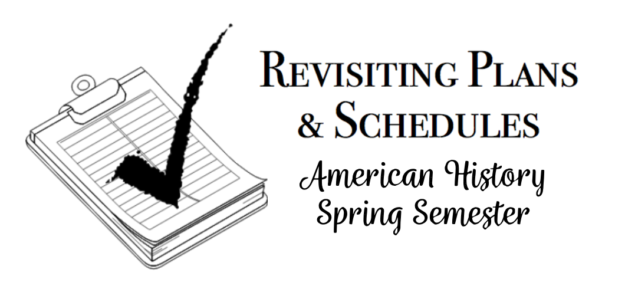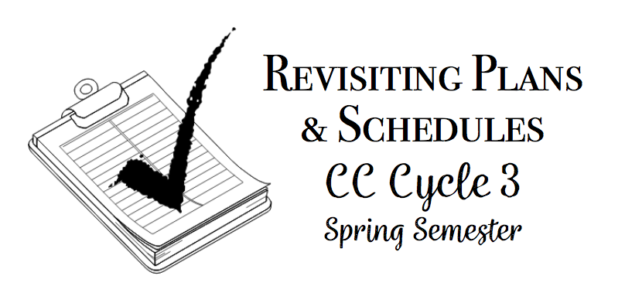So here we are, the third leg of the school year. When running a race, the third leg is the hardest. Enthusiasm and motivation have waned, you’ve fallen behind where you want to be, you’re worn out and exhausted, and the end is not yet in sight. It’s so easy to give up in the third lap.
Same goes with homeschooling.
I’m happy to say that thus far, things are going well. But tomorrow, we’ll be cranking back up after our holiday break. Through experience, I’ve come to approach this time of year with a bit of caution. After all, January and February are notorious for bursting my little utopian homeschool bubble. Before reality hits, let me remind myself. This time of year (or any time of year), it’s okay to rethink goals. It’s okay to set aside curriculum. It’s okay to slow the pace. It’s okay to take time to enjoy one another. It’s not just okay, it’s necessary.
So.. as I present our spring semester plans, let’s keep the big picture in mind. Even though plan doesn’t equal reality, without a plan, I’m lost. We don’t have a vision or direction or goals. So… I plan and then pray that God will
Teach us to number our days, that we may gain a heart of wisdom. Psalm 90:12, NIV
Part of numbering our days aright is planning well. Part of numbering our days aright is letting go of those plans when God has something else in store for our family. So… as we plan, we also hold onto those plans loosely realizing that God’s purposes are greater than our purposes. (Homeschooling is about relationships, not curriculum.)
We’ll start with the one thing that continues even if our other plans derail. It’s our family read aloud time, the most favorite part of our homeschooling adventure.
Our Read Aloud Selections for Second Semester:
We usually read a book together in the evenings the hour before we go to bed. (Notice I say “usually.” Sometimes we don’t get around to our read aloud time, which is okay.) We’re ahead of schedule on our original read aloud selections this spring because we ended up reading the adventures of Caddie Woodlawn over the break. Caddie Woodlawn was ranked as a very good book by our boys!
Here are the books we’ve scheduled to read this semester:






- Hattie Big Sky. A Newbery honor, this book follows the life of Hattie Brooks, who leaves Iowa to prove up a homestead claim in Montana.
- Journey To Topaz: A Story Of The Japanese-American Evacuation. A story of an 11-year-old Japanese girl and her family during the Japanese internment of World War II.
- Jacob DeShazer: Forgive Your Enemies (Christian Heroes : Then & Now). The story of Jacob Deshazer, a prisoner of war captured by the Japanese during World War II, who later returned to Japan to serve his former enemies as a missionary. I love-love-love the Christian Heroes: Then and Now series!
Visit this post for picture book selections.
Schedules
We usually read aloud our read-alouds in the evenings after supper. We also have a Morning Time consisting of short readings and/or activities we’d like to do to jumpstart our school day. But does this Morning Time thing happen every day? I’m afraid not. So before I get started with restating those plans, let me give you a simple rundown of what our core, bare-bones schedule sort of looks like (on paper at least).

When we add a Morning Time (and start our day with exercise. heh.), it looks more like this:

Last semester, our days didn’t go quite as planned, but it’s still my goal to work towards this routine. Now let’s take a look at our Morning Time Plans.
Morning Time
Bible. We begin our days with reading a couple of chapters of the Bible each morning and discussing as a family. (Although we simply read through the Bible now, devotionals we’ve enjoyed in the past have included Grapevine Bible Studies, Hero Tales: A Family Treasury of True Stories from the Lives of Christian Heroes, and Long Story Short: Ten-Minute Devotions to Draw Your Family to God .)
Geography. Our American History Reading Plan includes a schedule for working through learning to draw the USA from memory using Draw the USA by Kristin Draeger. We keep working towards mastery here.
Memory Work. We aim to follow our Memory Work Review Rotation schedule as provided in our Cycle 3 Planners and American History Reading Plans. After being through Cycle 3 thrice, the memory work is not a strong focus for us this year.
Science. Our boys enjoy Jay Wile’s Elementary Science Curriculum. The lessons are quick and interesting, the science experiments are simple and engaging (usually using items we can find around the house), and it’s a great way for us to incorporate some history into our science studies. This year we’re using Science in the Scientific Revolution. I’m not so concerned about finishing the book, though. Whatever we get out of it this year will be fantastic. (These books feed into Challenge B pretty well and can be used for the research strand in both Challenge A & B.)
Loop Schedule. Our loop schedule is how we touch on the “extras” that we’d like to incorporate but often let fall by the wayside. If you’ve never heard of a loop schedule, visit this page for an explanation. After publishing our Script-n-Scribe Americana book, we dropped art and poetry study from our loop because it was automatically built into our daily copywork.
Mid-Year Curriculum Update
In our mid-year reality check, I also mentioned how curricular adjustments were made over the course of last semester. Here’s what we’ve been using…
Math
- 3rd Grader: Singapore Math (Primary Mathematics) Level 3
- 6th Grader: Singapore Math (Primary Mathematics) Level 5
- 9th Grader: Saxon Algebra I with occasional Life of Fred Beginning Algebra. (He’ll be switching to Algebra II near the middle of this semester.)
Spelling, Copywork/Penmanship and Language Arts (3rd & 6th Grader)
- Spell to Write and Read for both, along with some additional tools/techniques from All About Spelling for our struggling speller (the 6th grader).
- Copywork/penmanship. Script-n-Scribe Americana, which includes American artist/art study, poetry, and a gentle introduction/review of English grammar concepts.
- Classical Conversations Essentials/IEW
(Our 9th grader is enrolled in Classical Conversations Challenge I, so, in addition to Algebra I/II, he’ll also be studying Economics, Team Policy Debate, American Literature, Exposition & Composition, Henle Latin I, Music Theory, and Physical Science.)
I would be amiss if I didn’t share some things we thoroughly enjoyed the last time we were studying American history. This is for folks who are interested in crafts, games, and recipes – families who aren’t also juggling the more rigorous schedule of middle/high school, and who truly want to dig in deeper with a fascinating study of American history. These studies are some of my most favorite learning memories when our children were all in elementary school. In fact, when we struggled to enjoy our homeschool, this is what we brought in to help us through the rough spots, especially during the months of January and February!
- Studying World War II: Maps, Timelines, Projects
- Hands-on History: Industrial Revolution, WWI, and the Great Depression
- Hands-on History: 20th Century Study
- Classical Music: Orchestra & Composer Study (This isn’t history, but we really enjoyed it during second semester!)
Well, I think that’s everything I can think of in a nutshell. Oh, wait. There is one more thing.
For I am confident of this very thing, that He who began a good work in you will perfect it until the day of Christ Jesus. Philippians 1:6
“God is faithful, more than capable to be faithful to the end – and finish what he started.” – MercyMe
If I’ve forgotten to explain something or if you have questions, just give me a shout! I’d love to hear from you!
Other Related Posts:
American History Loop Schedules (Cycle 3)
American History Reading Plans
CC Cycle 3 Planner
Adding a Bucket of Beauty to Homeschooling





